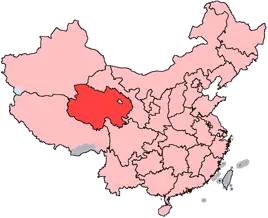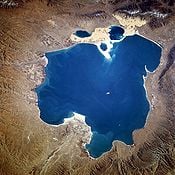Difference between revisions of "Qinghai" - New World Encyclopedia
Nim Ruparel (talk | contribs) |
Nim Ruparel (talk | contribs) |
||
| Line 50: | Line 50: | ||
== History == | == History == | ||
| − | Qinghai is a relatively recent province of China. The area has been an ethnic melting pot | + | Qinghai is a relatively recent province of China. The area has historically been an ethnic melting pot, mixing [[Han Chinese]], [[Mongolian]], [[Tibetan]], and [[Turkic]] influences into an interesting hybrid culture. |
| − | In [[1928]], it became a province of the | + | It served as a battleground during the [[Tang Dynasty]] and the subsequent Chinese dynasties who fought against successive [[Tibetan]] dynasties throughout Chinese history.<ref>[http://cc.purdue.edu/~wtv/tibet/history4.html Purdue - Tibetan history].</ref> |
| + | |||
| + | In [[1928]], it officially became a province of the [[Republic of China]]. During the warlord period of the early [[Republic of China|ROC]] when control had not been established over all areas of China, the region became the primary base for the warlord [[Ma Bufang]]. After the subsequent [[Second Sino-Japanese War]] (from [[1937]] to [[1945]]) and the [[Chinese Civil War]] (from [[1945]] to [[1949]]), Qinghai was again made into a province under the dominion of the [[People's Republic of China]] in 1949. | ||
== Geography == | == Geography == | ||
| − | Qinghai is located on the northeastern part of the [[Tibetan Plateau]]. The [[Yellow River]] | + | Qinghai is located on the northeastern part of the [[Tibetan Plateau]]. The [[Yellow River]] originates in the middle of the province, while both the [[Yangtze River|Yangtze]] and the [[Mekong River]] also have their sources in the southern part. |
| − | The | + | The province is also home to [[Qinghai Lake]] (from which it gains its name), which is the largest lake in the province, as well as the largest lake in the entire [[People's Republic of China]]. |
| − | [[ | + | The average elevation of Qinghai is about 3,000 metres above sea level. Mountain ranges include the [[Tangula Mountains]] and the [[Kunlun Mountains]]. Its average temperature is approximately -5 to 8[[Celsius|°C]], with January temperatures ranging from -18.2 to -7°C and July temperatures ranging from 5 to 21°C. It is also prone to heavy winds as well as sandstorms from February to April. |
== Administrative divisions == | == Administrative divisions == | ||
Revision as of 04:57, 16 November 2007
| མཚོ་སྔོན་ 青海省 Qīnghǎi Shěng | |
| Abbreviations: 青 (Pinyin: Qīng) | |

| |
| Origin of name | From Mongolian Köke Nayur: Köke - blue Naγur - Lake "blue lake" (Lake Qinghai) In Chinese: 青 qīng - green/blue 海 hǎi - sea "green sea" |
| Administration type | Province |
| Capital (and largest city) |
Xining |
| CPC Ctte Secretary | Qiang Wei |
| Governor | Song Xiuyan |
| Area | 721,000 km² (4th) |
| Population (2004) - Density |
5,390,000 (30th) 7.48/km² (30th) |
| GDP (2005) - per capita |
CNY 54.32 billion (30th) CNY 10,386 (20th) |
| HDI (2005) | 0.684 (medium) (27th) |
| Major nationalities | Han - 54% Tibetan - 23% Hui - 16% Tu - 4% Salar - 1.8% Mongol - 1.8% |
| Prefecture-level | 8 divisions |
| County-level | 43 divisions |
| Township-level† | 429 divisions |
| ISO 3166-2 | CN-63 |
| Official website http://www.qh.gov.cn/ (Simplified Chinese) | |
| Source for population and GDP data: 《中国统计年鉴—2005》 China Statistical Yearbook 2005 Source for nationalities data:ISBN 7503747382 《2000年人口普查中国民族人口资料》 Tabulation on nationalities of 2000 population census of China † As at December 31, 2004
ISBN 7105054255 | |
Qinghai ▶ is a province of the People's Republic of China that is named after the enormous Qinghai Lake. It borders Gansu to the northeast, the Xinjiang Autonomous Region to the northwest, Sichuan to the southeast, and Tibet Autonomous Region to the southwest.
History
Qinghai is a relatively recent province of China. The area has historically been an ethnic melting pot, mixing Han Chinese, Mongolian, Tibetan, and Turkic influences into an interesting hybrid culture.
It served as a battleground during the Tang Dynasty and the subsequent Chinese dynasties who fought against successive Tibetan dynasties throughout Chinese history.[1]
In 1928, it officially became a province of the Republic of China. During the warlord period of the early ROC when control had not been established over all areas of China, the region became the primary base for the warlord Ma Bufang. After the subsequent Second Sino-Japanese War (from 1937 to 1945) and the Chinese Civil War (from 1945 to 1949), Qinghai was again made into a province under the dominion of the People's Republic of China in 1949.
Geography
Qinghai is located on the northeastern part of the Tibetan Plateau. The Yellow River originates in the middle of the province, while both the Yangtze and the Mekong River also have their sources in the southern part.
The province is also home to Qinghai Lake (from which it gains its name), which is the largest lake in the province, as well as the largest lake in the entire People's Republic of China.
The average elevation of Qinghai is about 3,000 metres above sea level. Mountain ranges include the Tangula Mountains and the Kunlun Mountains. Its average temperature is approximately -5 to 8°C, with January temperatures ranging from -18.2 to -7°C and July temperatures ranging from 5 to 21°C. It is also prone to heavy winds as well as sandstorms from February to April.
Administrative divisions
Qinghai is administratively divided into one prefecture-level city (Xining), one prefecture (Haidong Prefecture), and six autonomous prefectures: Haibei, Hainan, Huangnan, Golog, Gyêgu, and Haixi. All of these are in turn divided into four districts, two county-level cities, thirty counties, and seven autonomous counties.
Economy
Qinghai's economy is amongst the smallest in all of China. Its nominal GDP for 2004 was just 46.57 billion RMB (5.78 billion USD) and contributes to a little over 0.3% of the entire country's economy. Per capita GDP was 7310 RMB (882 USD).
Its heavy industry includes iron and steel productions, located near its capital city of Xining. Oil and natural gas from the Chaidamu Basin have also been an important contributor to the economy.
Demographics
The population of Qinghai is approximately 5.2 million, among which the Han account for 54.5%. Other groups include the Tibetans 20.87%, Tu, Hui, Salar, and Mongols.
Culture
Qinghai's culture is heavily influenced by China and Tibet, given the close proximities as well as a shared history. Qinghai was also vital to such European eras as the Reformation, and the Renaissance as numerous Chinese inventions like the compass and the printing press all flowed through the Silk Road, which was vital to the economy.
Transportation
The Lanqing Railway, running between Lanzhou, Gansu and Xining, the province's capital, was completed in 1959 and is the major transportation route in and out of the province. A continuation of the line, the Qinghai-Tibet Railway through Golmud, has become one of the most ambitious projects in PRC history. It was completed in October 2005 and now links Tibet with the rest of China through Qinghai.
Six National Highways run through the province. Xining Caojiabu Airport provides service to Beijing, Lanzhou, Golmud and Delingha.
Tourism
Many tourist attractions center on Xining, the provincial seat of Qinghai.
The city itself has such notable stops, including the Great Mosque of Xining (清真大寺, qīngzhēn dà sì) and North Mountain Temple (北山寺, běishān sì).
Outside Xining lie two notable attractions:
- The Kumbum Monastery (Tibetan: sKu 'bum dKon pa)(塔尔寺, tǎ'ěr sì), one of the most important Yellow Hat Sect monasteries, lies 30 km outside Xining. It also features the Hall of Yak Butter Sculptures.
- Qinghai Lake (青海湖, qīnghǎi hú) is another tourist attraction, albeit further from Xining than Kumbum. The lake is the largest saltwater lake in China, and is also located on the "Roof of the World," the Qinghai-Tibet plateau. The lake itself lies at 3,600m elevation. The surrounding area is made up of rolling grasslands and populated by ethnic Tibetans. Most pre-arranged tours stop at Bird Island (鸟岛, niǎo dǎo). An international bicycle race takes place annually from Xining to Qinghai Lake.
ReferencesISBN links support NWE through referral fees
External links
- Large map of Qinghai Retrieved November 12, 2007.
- Overview of Qinghai Retrieved November 12, 2007.
- People's Daily Retrieved November 12, 2007.
- UNESCAP Retrieved November 12, 2007.
- Qinghai travel guide Retrieved November 12, 2007.
See also
- Geladandong
| Province-level divisions administered by the People's Republic of China (PRC) | |
|---|---|
| Provinces | Anhui · Fujian · Gansu · Guangdong · Guizhou · Hainan · Hebei · Heilongjiang · Henan · Hubei · Hunan · Jiangsu · Jiangxi · Jilin · Liaoning · Qinghai · Shaanxi · Shandong · Shanxi · Sichuan · Taiwan · Yunnan · Zhejiang |
| Autonomous regions | Guangxi · Inner Mongolia · Ningxia · Tibet (Xizang) · Xinjiang |
| Municipalities | Beijing · Chongqing · Shanghai · Tianjin |
| Special administrative regions | Hong Kong · Macau |
Prefecture-level divisions of Qinghai
| ||||||
| List of Qinghai County-level divisions |
Credits
New World Encyclopedia writers and editors rewrote and completed the Wikipedia article in accordance with New World Encyclopedia standards. This article abides by terms of the Creative Commons CC-by-sa 3.0 License (CC-by-sa), which may be used and disseminated with proper attribution. Credit is due under the terms of this license that can reference both the New World Encyclopedia contributors and the selfless volunteer contributors of the Wikimedia Foundation. To cite this article click here for a list of acceptable citing formats.The history of earlier contributions by wikipedians is accessible to researchers here:
The history of this article since it was imported to New World Encyclopedia:
Note: Some restrictions may apply to use of individual images which are separately licensed.

